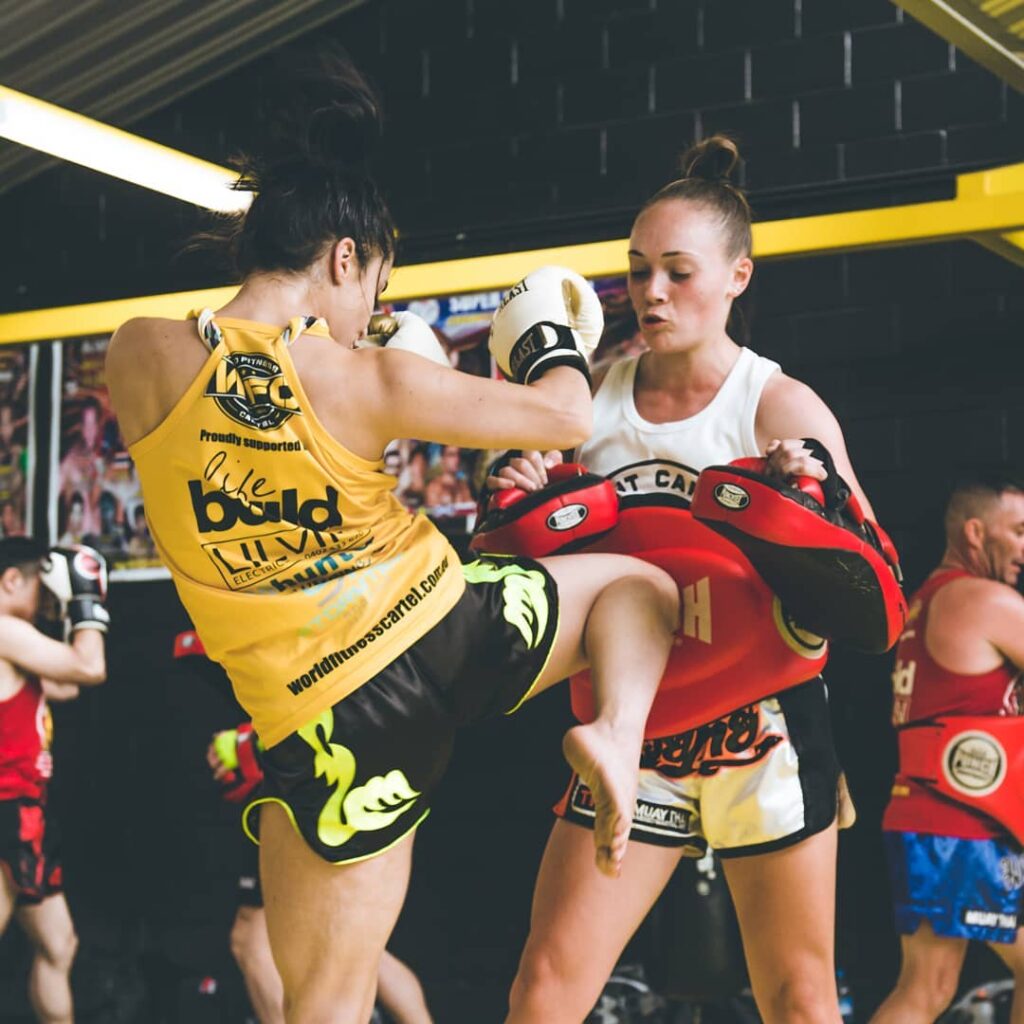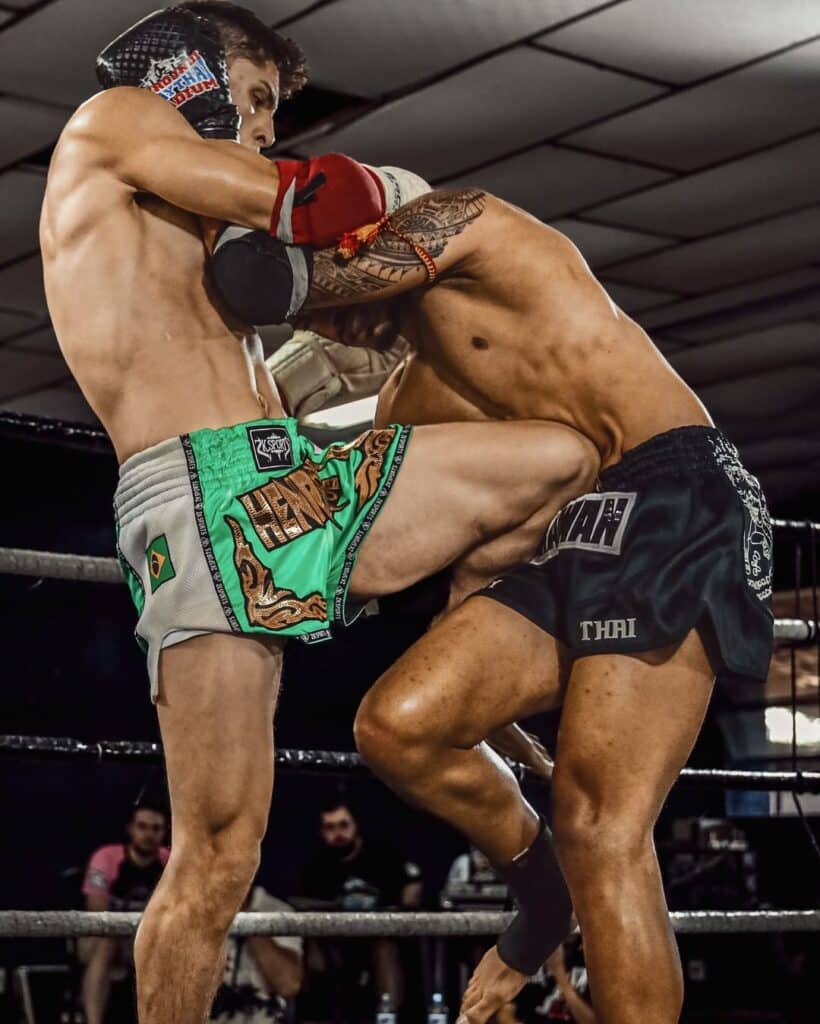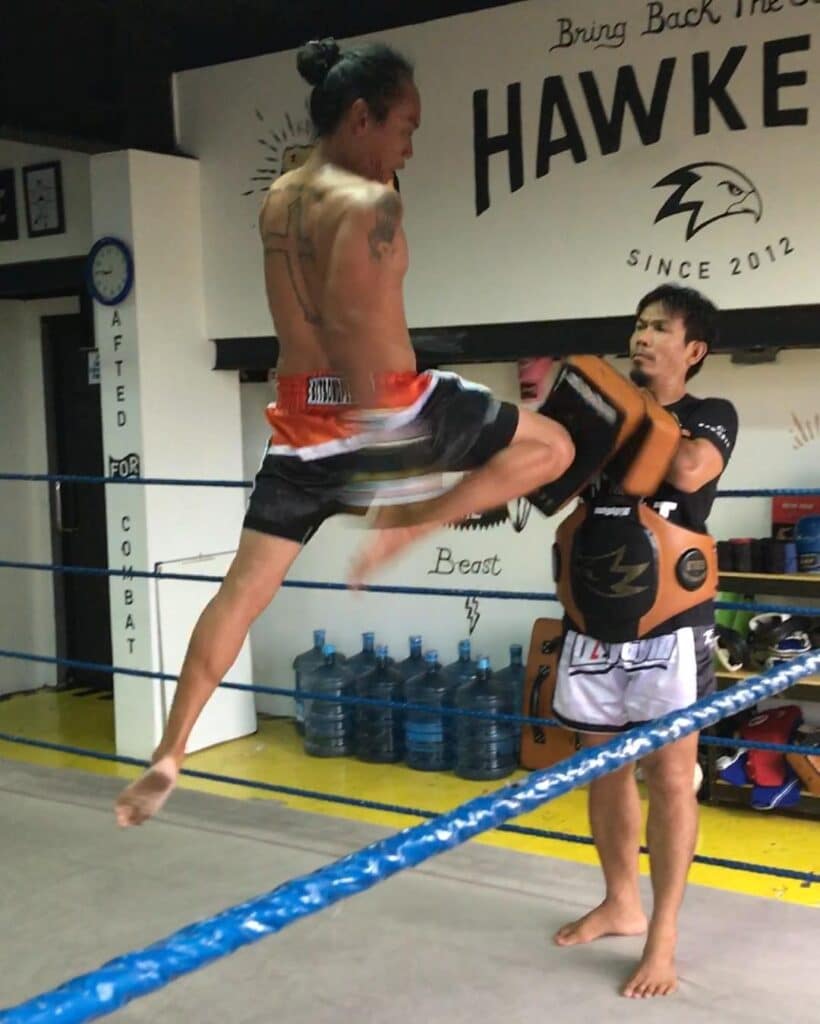Muay Thai Knees: Explained
In the world of competitive combat sports, among the diverse array of techniques, few command as much respect or bring as much devastation as a well timed Muay Thai Knee.
During the golden age of Thai boxing, legendary bouts unfolded where warriors like the great Muay Khao; Dieselnoi Chor Thanasukarn honed their craft in iconic arenas like Lumpinee Stadium, these bouts became not just displays of skill but also reflections of Thailand’s rich cultural heritage and tradition, with each knee a testament to skill and strategy and the ever evolving sport of modern Muay Thai.
In this article, we delve deep into the world of the Thai Boxer, exploring the techniques and applications of the various Muay Thai Knees.
Types of Muay Thai Knees
The Muay Thai knee can be broken up into many different forms with each knee thrown typically being either one of the six clear and individually named knee strikes or an amalgamation of 2 or more.
1. Khao Chiang

Diagonal Knee: The Khao Chiang is a diagonal Muay Thai knee that targets the opponent’s midsection or ribs. The movement involves lifting the knee diagonally across the body while turning the hips and shoulders in the direction of the strike (in a similar fashion to a body kick).
This technique is effective for attacking angles not covered by traditional straight knees. It is also effective as a step-in knee from middle range to punish heavy punchers as well as during brief moments of distance in the clinch.
2. Khao Tat
Horizontal Knee: The Khao Tat is a horizontal Muay Thai knee that travels parallel to the ground, targeting the opponent’s body or head at a horizontal angle. The knee is thrust forward in a straight line, with the hips driving the movement forward with power,
This technique is effective for close-range combat and can be used to counter opponents attempting to close the distance or clinch. Additionally, it can serve as a shield to block incoming knees from opponents and create distance in the clinch.
3. Khao Trong

Straight Knee: The Khao Trong, perhaps the most recognizable of the Muay Thai knees, is delivered directly forward typically targeting the opponent’s solar plexus or head with occasionally targeting the thigh in the clinch. The knee is raised straight up, with minimal rotation of the hips, making it a quick and direct attack.
This technique is versatile and can be used in various situations, such as from the clinch, as a follow-up to other strikes or to close distance and set up angles for subsequent elbows.
4. Khao Khong
Curving Knee: The Khao Khong is a curving Muay Thai knee that follows a circular path, specifically during the clinch. The knee is raised in a curve, with the hips rotating in conjunction with torquing the opponents upper body to generate power.
This technique is effective for catching opponents unaware in the clinch, specifically when combined with feints or partial sweeps.
5. Khao Yao
Knee Bomb: The Khao Yao, also known as the knee bomb, is a powerful knee strike aimed at inflicting maximum damage on the opponent. It involves explosively driving the knee upward with full force often targeting the opponent’s body, head, or ribs.
The movement requires a strong push from the supporting leg and a quick extension of the knee for maximum impact, the Khao Yao typically incorporates a step or skip forward following a teep or feint, particularly effective with the opponent coming forward off the ropes.
6. Khao Loi

Flying Knee: The Khao Loi is often initiated from a jumping or lunging position. The fighter propels forward, lifting the knee explosively to target the opponent’s head, chest, or midsection. The movement combines forward momentum with a rapid knee extension, aiming to deliver a significant impact to the opponent.
Similarly to the Khao Yao the flying knee is very effective at punishing backwards movement from your opponent after a teep or punch. Additionally it can be very effective following a pattern of teeps and feints, forcing an opponent’s guard to drop in preparation for launching the attack.
Using Knees in Muay Thai
The Knee in Muay Thai is perhaps one of the most versatile weapons available to a talented fighter. They can be effectively applied across various ranges and used as either a sword or a shield in the ring; applied through offensive or defensive strategies, both within and outside of the clinch.
Short Range
Perhaps the most expected and arguably the most dangerous application of Muay Thai Knees are within short range close quarters fighting.
At shorter ranges knee strikes become potent tools for inflicting damage and disrupting an opponent’s rhythm. Short-range knee strikes, such as the Khao Tat (Horizontal Knee) and Khao Chiang (Diagonal Knee) are quick and powerful, ideal for exploiting openings in an opponent’s guard or countering incoming strikes. These Muay Thai knees can be launched from the clinch or during exchanges in tight spaces.
Defensively in short range knees can be very effective at either deterring continual punching by opponents through punishing counters or by shielding knees and or kicks by blocking their momentum and preventing the opponent from raising their leg unimpeded from a horizontal cross body position.
Medium Range
In the mid-range, Muay Thai knees like the Khao Trong (Straight Knee) come into play. These techniques offer a balance of speed, accuracy, and power, making them effective for establishing dominance and creating distance. The Khao Trong, for example, can be used to keep opponents at bay or be used in combinations as a way to close distance effectively.
Using knees defensively in medium range work well to punish mistimed kicks or punches as well as using well timed straight knees to catch advancing opponents as they step forward, this will quickly become an effective deterrent for a punch or knee heavy fighter.
Long Range
At longer distances, Muay Thai knees may seem less viable, but techniques like the Khao Loi (Flying Knee) can bridge the gap effectively. A well-timed flying knee can catch opponents off guard, especially when they attempt to close the distance or retreat.
At long range the knees suffer, any situation where you might think to use a knee defensively, at this range a kick will almost always be more beneficial.
Knees in the Clinch
In the clinch, knees are central to both offensive and defensive strategies, offering a range of techniques for controlling the opponent, setting up sweeps, baiting counters, and targeting specific body parts.
Fighters can adjust the angle and force of their knee strikes based on the opponent’s stance and defensive posture, maximising the impact on vulnerable areas.
Different arm and grip placements in the clinch can complement specific knee techniques. For example, a full clinch can facilitate close-range Muay Thai knees like the Khao Trong, while an over-under grip can set up powerful horizontal knee strikes like the Khao Tat. Understanding how to leverage arm and grip positions enhances a fighter’s ability to execute a diverse range of Muay Thai knees effectively in the clinch.
Offensively, fighters use knees in the clinch to wear down opponents and score points. The Khao Khong (Curving Knee), Khao Chiang (Diagonal Knee) and Khao Trong (Straight Knee) are by far the most effective offensive knees during the clinch with the Khao Yao (Knee Bomb) and Khao Loi (Flying Knee) see limited use; mainly through follow up shots after the clinch breaks and the fighters separate.
A combination of all of the knee techniques (except the two previously mentioned) are very powerful options for delivering relentless knee barrages that work to debilitate your opponent, score points or secure a knockout.
Defensively, knees in the clinch serve to control the opponent’s posture and limit their offensive options. Fighters can use techniques like the Khao Khong (Curving Knee) or Khao Tat (Horizontal Knee) defensively to disrupt an opponent’s balance, nullify their strikes, and create opportunities to break free or transition to a dominant position or follow up elbow strike.
Setting up sweeps in the clinch often involves using knees strategically to off-balance opponents. By alternating between different Muay Thai knees, feints and positional changes, fighters can keep opponents off-balance and susceptible to either heavier, more damaging knees and elbows or high scoring often demoralising sweeps. This tactic requires timing and awareness of the opponent’s weight distribution and movements.
Baiting counters through purposeful repeated knee patterns is another advanced strategy in the clinch. By establishing a predictable pattern of knee strikes, fighters can lure opponents into countering, only to exploit those counters with well-timed blocks, sweeps, or counter knees of their own.
Targeting different body parts, such as the thigh with knees in the clinch can be effective for disrupting an opponent’s mobility. While typically not a common occurrence, repeated knees to the thigh in the clinch especially when locked in too close to land more damaging shots to the mid-section can result in slowing opponents down, which can be very useful against particularly elusive Muay Femur or Muay Tae fighters.
In the dynamic world of combat sports, Muay Thai knees stand as formidable weapons, blending ancient tradition with modern combat excellence.
From devastating power to strategic finesse, these techniques epitomize the art’s versatility and effectiveness. As fighters continue to evolve their skills, the legacy of the Muay Thai knee endures, a testament to the enduring spirit of martial arts excellence.


